Travel Development in and about a Great City
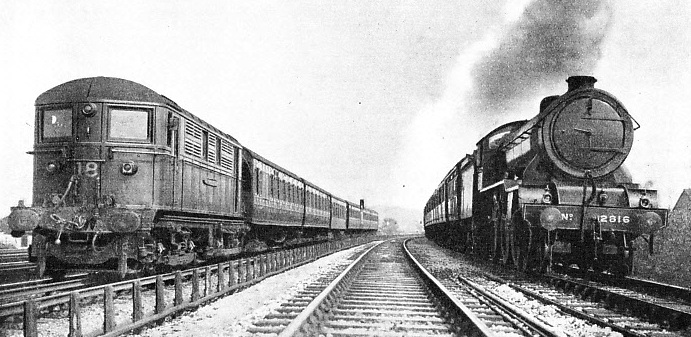
STEAM AND ELECTRICITY COMBINE to serve London’s millions. Here is a Pullman car train hauled by the electric locomotive “Michael Faraday” on the Metropolitan line between Baker Street and Aylesbury, Bucks. To the right is the 4.55 pm Manchester express shortly after having left the LNER terminus at Marylebone.
NOT only is London one of the largest cities in the world, but it is also one of the greatest railway centres, and the first capital to be served by a public railway. Within a radius of twenty-five miles from its centre there are a larger railway mileage than in any other area of comparable size, a larger number of stations, and the greatest suburban electric railway network in the world. Even in an age that accepts superlatives as a matter of course, those records are noteworthy.
The fascinating story of this development of just under a century has yet to be told in detail, and only a sketch can be essayed here. There are so many phases to chronicle. First, the railway entered London as a means of communication with the rest of Great Britain; then the suburban network began to be created; afterwards came the underground railway as a purely short-distance means of communication. Then came the Tubes, electrification on the grand scale, and the linking up of the short underground systems with the main lines and with one another And there is another exceptionally interesting chapter in the history of the passenger train services that have vanished, either under the pressure of modern conditions, or because new and improved facilities have rendered them superfluous.
It is difficult, if not impossible, to realise to-day a London without railways, as it was until the coming of the London and Greenwich Railway in 1836. As late as 1800 there was still only one canal entering the city, because the Government forbade coal to be carried to the capital except by sea. This was to encourage the Newcastle coastal shipping trade, then regarded as a nursery for seamen. When the railway did eventually enter London, it played a limited if important role for a number of years.
There is to-day a tendency to forget the disputes - often long and embittered - between railway companies that were for many years so characteristic of English railway history. A minor dispute, but one that might have had important consequences, marked the first year of the Metropolitan. When this line, the pioneer urban underground system, was opened in the beginning of 1863, the initial section between Paddington (Bishop’s Road) and Farringdon Street (now Farringdon and High Holborn) was at first worked by the Great Western Railway, since the “Met” had not yet taken possession of any locomotives or coaches. After six months a disagreement arose between the two companies, and the Great Western gave a few days’ notice of its intention to withdraw the working stock, thinking in this way to force the smaller undertaking to come to terms. But the authorities at Paddington had forgotten one highly important factor.
The underground line was laid on the mixed gauge, and the Metropolitan was able to borrow the necessary equipment from the Great Northern and London and North Western Railways until its own was ready. Since the traffic for the first three weeks of operation averaged over 29,000 passengers a day, it will be realised that a considerable degree of public inconvenience would have resulted from even a temporary suspension of the service. The Great Northern’s reason for coming to the assistance of its smaller neighbour were, perhaps, not entirely disinterested. Since 1863 it had operated a through suburban service over the Metropolitan, by means of a connecting line, at King’s Cross. At first this service ended at Farringdon Street, but it was shortly afterwards extended to Moorgate, which still acts as a subsidiary LNER terminus. It is on record that, “in celebration of the first through journey from the Great Northern main line, the passengers launched a frontal attack on the refreshment-room at Farringdon Street, and in a short time consumed all its contents”.
Moorgate thus occupies a somewhat exceptional position on the London railway map, serving both as a through station on the Metropolitan Section of the Underground system, and as a terminus for one of the main railways. It also furnishes an instance of a vanished service, that formerly provided by the South Eastern and Chatham.
At one time the Metropolitan was to have been an important link in a grandiose scheme that to some extent anticipated grouping. Sir Edward Watkin, its chairman, who was “gifted with a superb imagination which made light of difficulties”, planned a great north-to-south trunk line uniting the Manchester, Sheffield and Lincolnshire Railway with the South Eastern (with both of which he was also connected). The Metropolitan was to serve as the connecting link. He even went farther, by proposing that his trunk line should be connected with a Channel Tunnel, and “cross London and carry the coal of the South Yorkshire coal fields, the merchandise of Lancashire, and the passengers of the whole of the North of England to Paris and the entire continent of Europe”. Watkin’s dream did not remain entirely a project, since dogged persistence eventually brought the Sheffield line to London - in 1899 - when it changed its title to Great Central. This system, now embodied in the LNER, was the last of the main lines to enter London, and it seems unlikely that we shall see another.
A “General Terminus”
The period between 1860 and 1870, during which the present Willesden Junction was opened and through communication provided between the main lines north and south of the Thames by means of the West London and West London Extension Railways, is particularly rich in examples of now extinct through short-distance passenger workings on to “foreign” lines. The London, Brighton and South Coast Railway was at the time using the South Eastern’s Cannon Street as an auxiliary terminus, and this station was served also by the London and North Western Railway, while both the Great Western and the North Western used Victoria.
The latter station was opened in 1860, with the primary purpose of providing a West End terminus for the London, Brighton and South Coast and London, Chatham and Dover Railways. Neither of these systems was, however, directly concerned in its construction, which was undertaken by a separate undertaking. The Victoria Station and Pimlico Railway Company was incorporated in 1858 “to construct a general terminus at Pimlico, and a line to be connected with the West End and Crystal Palace at Battersea”. The phrase, “general terminus”, is of particular interest, since Victoria provides the nearest approach that London possesses to the “union stations” so common in the United States, and of which the English capital would also have had at least one - in the West End, or possibly in the Strand - if certain early schemes had ever materialised.
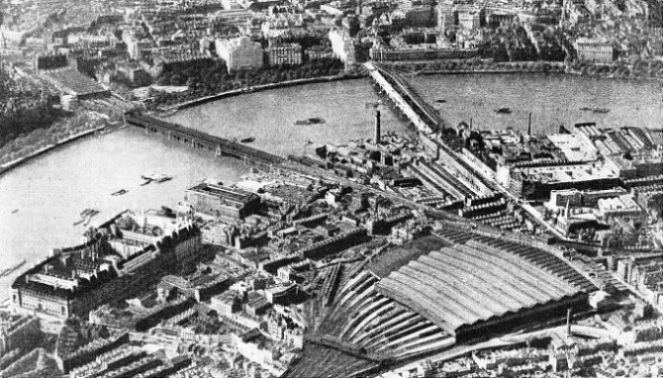
GREAT BRITAIN’S LARGEST STATION, Waterloo, can be seen in the foreground of this aerial photograph. On the far side of it, to the right, is Waterloo Junction, with the lines of the Eastern Section of the Southern Railway coming in, and running over the river across Hungerford Bridge (left) to Charing Cross Station. The old and new (temporary) Waterloo Bridges can also be seen.
These projects mainly envisaged a terminal station in the Central London area to be used by several companies, and a more restricted scheme of the kind very nearly materialised. This was for a joint station - at Euston - for the Great Western and London and Birmingham Railways. The plan got so far as to be embodied in the Great Western’s Act of Parliament of 1835. Because, however, of what was at a later date officially described as “friction between the companies”, the Great Western directors decided to have a station of their own, and chose a site “in the then countrified suburb of Paddington”. This station was a small building, about half a mile to the west of the present terminus. So anxious was the company to push on with the completion of the line, which, of course, involved a change of route on the last few miles of the approach to London, that building was begun on the section into Paddington before Parliamentary sanction had been obtained for the alteration.
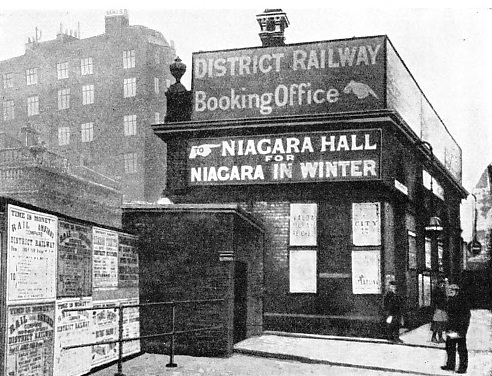
ST JAMES’ PARK STATION. The entrance to this District Station as it appeared in the pre-electrification days. The Gloucester Road to Westminster section of the District Railway, on which is St James’ Park Station, was opened in December, 1868.
But to return to Victoria. The route length of the Pimlico Railway was a mile and a quarter, which included the section of the bridge across the Thames. A year after the opening of the station, the Chatham and Dover portion was jointly leased to that company and the Great Western for a period of 999 years, on the basis of an increasing rental. This arrangement, of course, necessitated the laying of broad-gauge tracks, which the Great Western had already been authorised to do in 1859. The Brighton hall of the terminus was used also by the London and North Western Railway, under a toll arrangement. The Victoria Station and Pimlico Company continued to exist as a separate undertaking until 1923, when it was absorbed by the Southern Railway under the grouping scheme, but the Great Western and London and North Western services had been withdrawn long before that date.
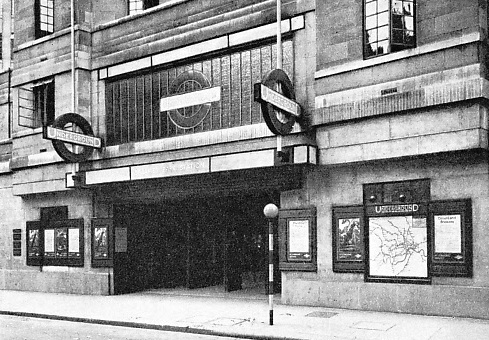
THE MODERN UNDERGROUND STATION entrance is typified by St James’ Park Station as it is to-day. The large illuminated map of all London’s underground routes outside the station is typical of the efficiency with which the organization now serves its passengers.
It may perhaps be asked why through services of this nature, some operating over a relatively long mileage, should have been provided so many years ago but should not be available to-day. According to one authority, “these excessively circuitous workings were due to the comparative lack of adequate omnibus services; the rail route, however roundabout, was better than the rumbling omnibus”. The Inner Circle Railway, now an integral part of London Transport, was not finished until 1884 - twenty-one years after the inauguration of the Metropolitan - and that there was no through communication between the District and the West London Railways until 1872. Railway passengers were often obliged to choose between the “excessively circuitous” routes or none. Moreover, there were, of course, no Tubes, and the first regular tramway service in the Metropolitan area was not working until 1870. The pioneer tram line between the Marble Arch and Notting Hill Gate, which was opened in 1861 with so much pomp and ceremony and feasting, was taken up very soon afterwards, partly because the projecting rail flanges were found to be a source of inconvenience to other road users. Finally, the expansion in recent years of the Underground system, until most of its mileage lies on the surface, has changed the whole face of London’s transport.
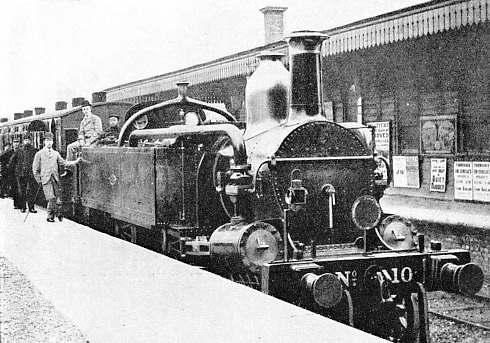
THE METROPOLITAN DISTRICT RAILWAY, familiarly known as the “District”, was originally steam-operated. This picture shows one of the early trains at West Brompton Station. The first section of the District, from High Street, Kensington, to Gloucester Road, was opened in October, 1868.
The “rumbling omnibus” was at one time a direct railway interest, the Metropolitan operating a service in the West End. This ran between Portland Road (now Great Portland Street) Station and Piccadilly Circus, and had three peculiarities. The vehicles adopted the Continental practice of carrying two classes of passenger; they were drawn by three horses, and they carried a large umbrella. The last gave its distinctive name to the service, which was worked for only a brief period. and never received Parliamentary sanction.
Another vanished through service of the 1860-1870 era was that inaugurated in 1865 between Euston and London Bridge, via Kensington (Addison Road) and Vauxhall, and extended to Cannon Street during the following year. It never met with much patronage, and its principal direct result appears to have been to add to the congestion at Cannon Street and complicate still further the traffic working at that station. But, indirectly at least, it was responsible for the construction of Waterloo Junction. It appears “the South Western complained that the South Eastern Company were deliberately discouraging the service, as they were, and at last they gave that company notice to complete their engagements and build Waterloo Junction”. They built this station distinctly against their will. But, as some measure of compensation, they asked that the through service be taken off, and it was discontinued on New Year's Day, 1867.
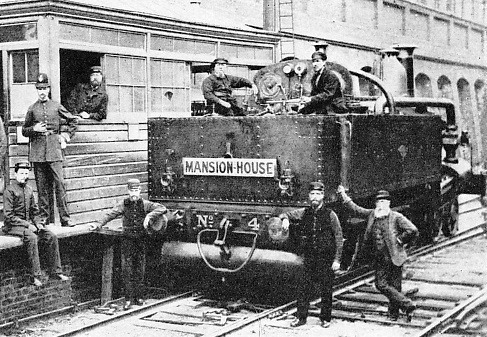 ON THE “INNER CIRCLE”. The name originated when the lines of the “District” and the Metropolitan met to form an irregular oval. This last gap on the railway loop beneath London was from Mansion House to Moorgate Street. The whole of the “Inner Circle Railway” was opened in 1884. The last steam trains were withdrawn on this line in 1905. This photograph shows one of the old-time steam locomotives of the District railway at Mansion House Station.
ON THE “INNER CIRCLE”. The name originated when the lines of the “District” and the Metropolitan met to form an irregular oval. This last gap on the railway loop beneath London was from Mansion House to Moorgate Street. The whole of the “Inner Circle Railway” was opened in 1884. The last steam trains were withdrawn on this line in 1905. This photograph shows one of the old-time steam locomotives of the District railway at Mansion House Station.
The most celebrated, and probably the most generally useful, of all these vanished services was the “Outer Circle”, which was worked over the tracks of no fewer than five companies - the North London, London and North Western, West London, West London Extension, and District Railways. The North Western provided the locomotives and rolling-stock. The route traversed was between Broad Street and Mansion House, via Hampstead Heath, Willesden Junction, Addison Road, and Earl’s Court, and the two termini were within a mile of each other. On the electrification of the District Railway, which resulted in a great and immediate increase in that company’s services, the section between Earl’s Court and Mansion House became too congested to handle any “foreign” traffic. All that is now left of the “Outer Circle” service is that provided by LMS electric trains between Willesden Junction and Earl’s Court.
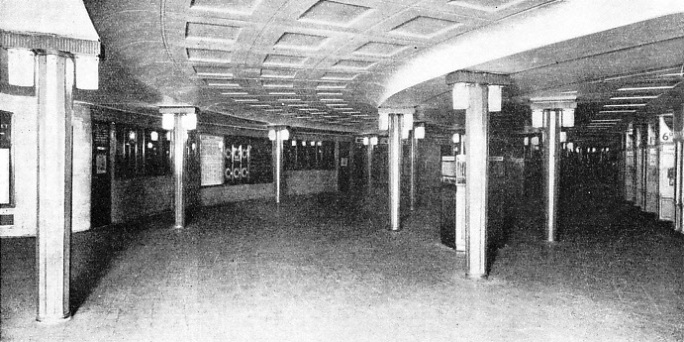
EQUIPPED IN MODERN STYLE. This is a section of the large circular underground ticket hall at Piccadilly Station, on the Piccadilly Line. The first section of this line between Hammersmith and Finsbury Park was completed in December, 1906. It is now under the direct control of the London Passenger Transport Board.
The Great Western used also for many years to operate a service - the “Middle Circle” - between Mansion House and Moorgate, via Addison Road. An interesting feature of the working on this route was that, while locomotive power was invariably provided by the Great Western, some of the trains were made up of District Railway coaches. In this connection, it may be recalled that in the days of steam operation, the Inner Circle service were worked jointly by the Metropolitan and District, each company running an agreed proportion of trains on the route. This arrangement continued for some considerable period after electrification, but in 1926 the District trains were withdrawn except on Sundays.
The “Middle Circle” service was replaced by one between Moorgate and Addison Road on the electrification of the Metropolitan, when, because of Great Western’s partnership in the Hammersmith and City Line, it became worked by the first jointly owned electric passenger stock in the kingdom.
Joint stock, built for the London Electric and London and North Western Railways, was introduced in 1920 for the Bakerloo through service to Watford. This deserves special mention as a characteristic example of developments that have rendered the old through services unnecessary. On its opening, in 1906, the Bakerloo Tube was a short and entirely underground line, with termini at Baker Street and Waterloo. It gradually outgrew the boundaries of the central London area, extending to Elephant and Castle on the south and to Queen’s Park on the north.
A “Ghost Station”
To Queen’s Park Station, which is on the LMS main line (Western Section), the Tube trains began to run in 1915. Two years later Watford was reached (over the LMS tracks), though until 1917 the service was worked only on weekdays. Since then, the London Electric Railway has been linked to both the District and the City and South London systems, and the latter has in turn extended southwards to Morden, while there are now also two separate “Underground” routes (largely on the surface) to Uxbridge, Ealing, and Hounslow.
From the beginning the Tubes provided accommodation for only one class of passenger, while the Metropolitan and District originally had three classes. Following the example of the main-line companies, these have since electrification been reduced to two, while the District has gone further by abolishing first class on the Harrow Line services. The single class on the Tubes was originally justified by the contention that such accommodation would be adequate for very short journeys, but the systems have since become miniature main lines. Here is an interesting example of differences in railway practice that would seem to be based mainly on custom. But urban underground railways vary in their practice, the Paris “Metro” having two classes, while the New York Subway provides only one.
Side by side with the provision of new and improved facilities has gone the closing of passenger stations to traffic. This has been carried out to the most noteworthy extent on the Eastern Section of the Southern Railway, where motor omnibus and tramway competition were the original causes. Another example is the Midland main-line approach to St. Pancras. Elsewhere, new stations have rendered older structures superfluous, as on the District Railway and on the Tubes.
For instance, when Knightsbridge Station on the Piccadilly Line was opened in 1934, Brompton Road was closed. This station was officially described as having been “for many years past the least used of the London Passenger Transport Board’s stations in Central London”. And there is the Central London’s “ghost station” - British Museum - which still exists, but has been disused since the reconstruction of Holborn enabled that station to be used as an interchange point between the Piccadilly and Central London Tubes. The multiplication of these interchange stations is among the most striking improvements in travelling facilities that have been made since the beginning of the present [20th] century.
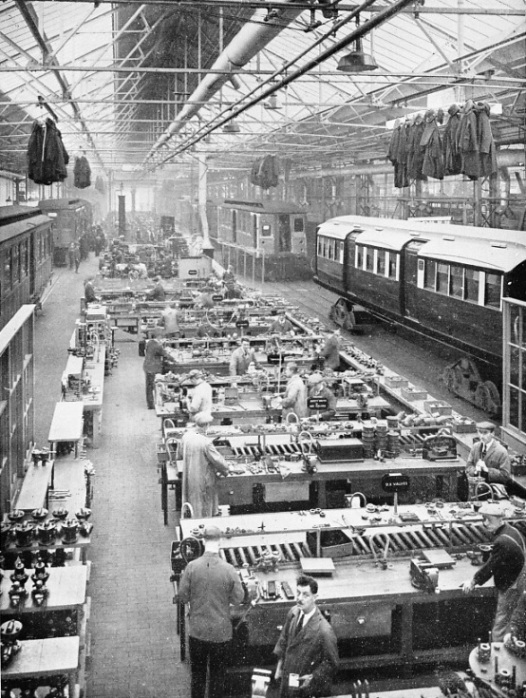
THE OVERHAUL OF UNDERGROUND ROLLING STOCK owned by the London Passenger Transport Board is carried out at their Acton Works, Middlesex. The picture shows a section of the car body shop where brake equipment is handled. Units to be overhauled here, which include drivers’ brake valves, triple valves, tripcocks and air door engines, are distributed to the repair benches by a moving conveyor. The number of cars overhauled each year at Acton amounts to about 1,500.
Reference has been made in this chapter to vanished train services. There is also an instance of revival after many years of suspension. A junction at Baker Street permits of through running between the Metropolitan’s City and Extension lines. Many years ago the service was withdrawn, and it was not restored until after the electrification of the system, when improved signalling methods were introduced. It is on these through services that the only Pullman cars on the “Underground” are operated. Another distinction of the London railway system is that in no other city in the world are Pullmans provided for the exclusive benefit of suburban passengers.
The provision of such amenities is the more remarkable when it is recalled that for many years some of the main-line companies, if they did not go out of their way to discourage the suburban traveller, did very little in the way of encouraging him. This attitude was at one time especially marked on the London and North Western. The “premier line”, although it showed considerable enterprise in operating short-distance through service to such “foreign” destinations as Croydon, ran the barest minimum of trains between Euston and stations south of Watford, The policy is nowadays difficult to understand, except on the assumption that it may have been a relic of the autocratic methods of the London and Birmingham Company, and what makes it even more difficult to understand is that the suburban stations between Euston and Willesden Junction were designed on so lavish a scale that, even with the present intensive electric short-distance service, the platform accommodation at some is still in excess of requirements.
The “Five Year Plan”
The short-distance passenger in the London area can certainly not complain to-day that his patronage is not required. Immense sums have been spent during the past few years on new lines, extensions, and improvements. On the London, Tilbury and Southend Section alone of the LMS no fewer than eight new stations have been opened recently. Thirty-five millions are to be spent in the near future on the “Five Year Plan” of suburban electrification. The capital outlay on the London railway system has thus been out of all proportion to that on the main lines. And the average cost per mile of the British main lines is claimed to have been greater than that in any other country in the world. One feature of the “Five Year Plan” - the linking up of the Great Northern and City Tube with the main-line Great Northern Section of the LNER - is of exceptional interest, since this Tube was the only one constructed expressly with a view to through running on to a main line. The connection was to have been with the Great Northern at Finsbury Park. For this reason the tunnel diameter is greater than the standard 11 ft 8½ in of the other Tubes, which is in itself materially in excess of the 10 ft 6 in of the City and South London as originally constructed. But although main-line rolling stock can thus be accommodated, the junction with the Great Northern was never built, because of yet another of those disagreements to which reference has already been made. Now the scheme is being revived after an interval of more than forty years.
It is difficult to say whether the most remarkable development of the London railway system during the past thirty years has been the provision of new and improved facilities or the vast speeding-up of the train services. Accelerations has made possible a spectacular increase in train movements. Just before the abolition of the steam haulage on the District, the maximum number of trains that it was possible to operate during the rush hours was fourteen to sixteen on either track. The figure is now forty, and represents a remarkable achievement in terms of percentages.
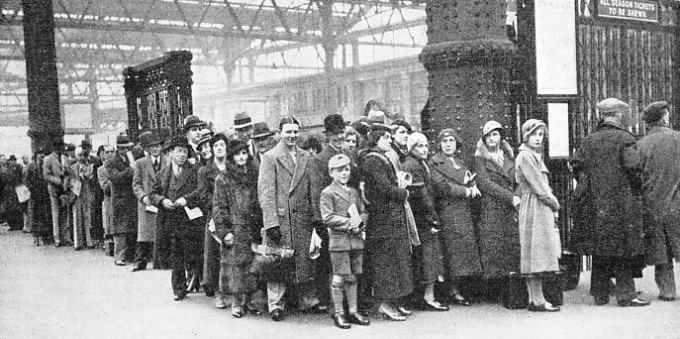
THE EXODUS from the City at week-ends and on bank-holidays is a characteristic feature at London termini nearly all the year round, Here is a typical crowd queuing up for a holiday train at Waterloo Station.
You can read more on “During the Rush Hours”, “Railways Under London” and “Special Passenger Traffic” on this website.








 ON THE “INNER CIRCLE”. The name originated when the lines of the “District” and the Metropolitan met to form an irregular oval. This last gap on the railway loop beneath London was from Mansion House to Moorgate Street. The whole of the “Inner Circle Railway” was opened in 1884. The last steam trains were withdrawn on this line in 1905. This photograph shows one of the old-
ON THE “INNER CIRCLE”. The name originated when the lines of the “District” and the Metropolitan met to form an irregular oval. This last gap on the railway loop beneath London was from Mansion House to Moorgate Street. The whole of the “Inner Circle Railway” was opened in 1884. The last steam trains were withdrawn on this line in 1905. This photograph shows one of the old-

